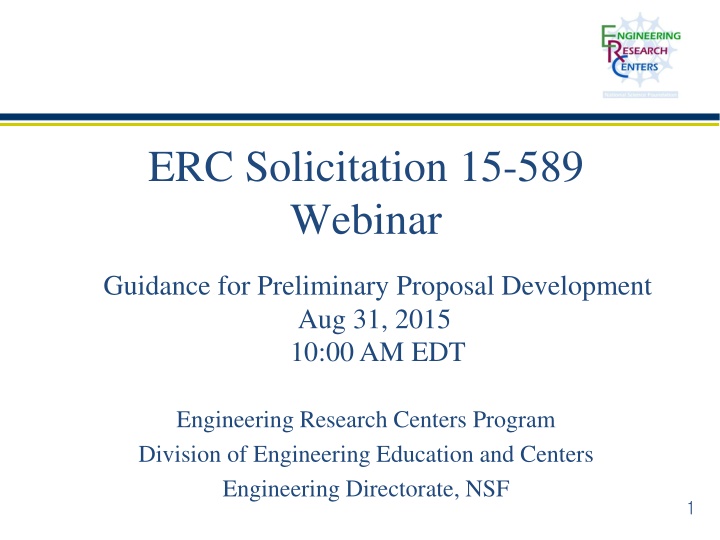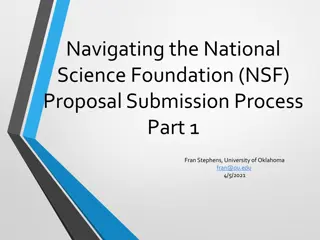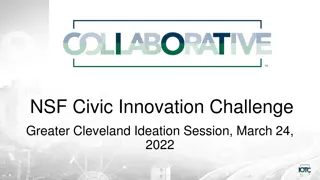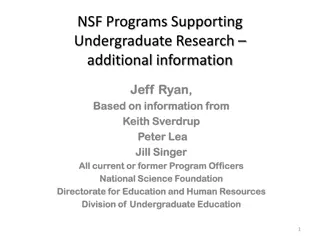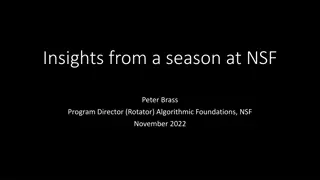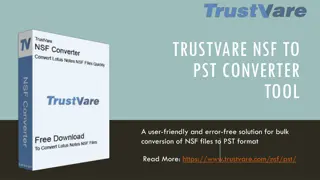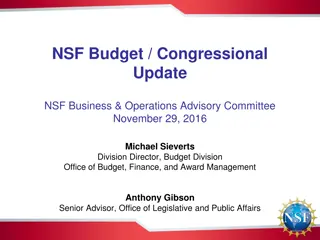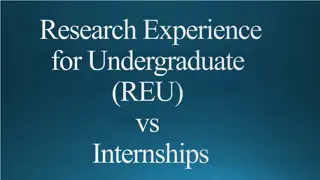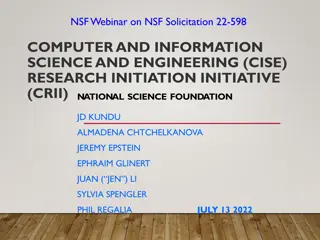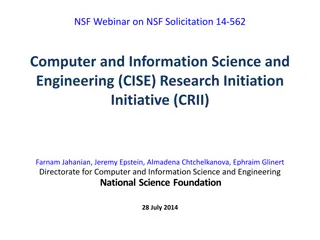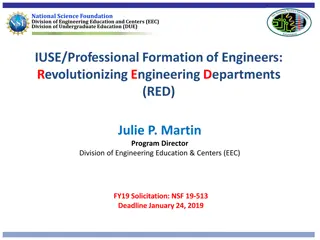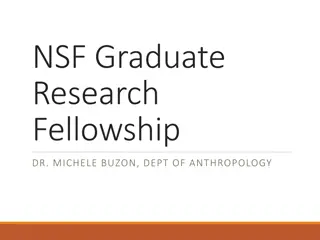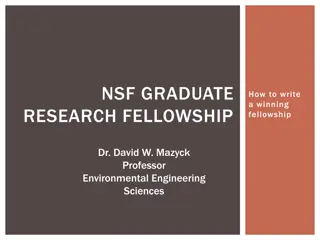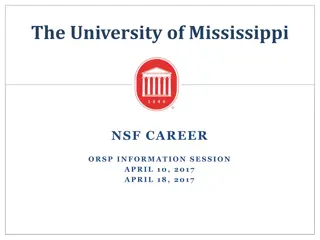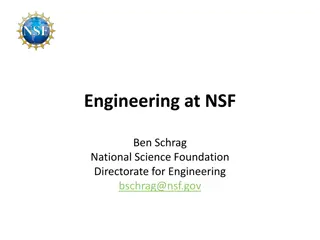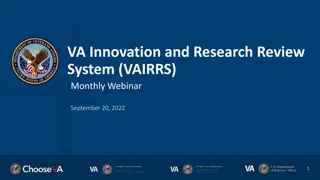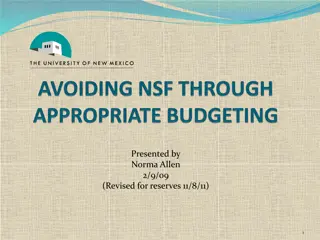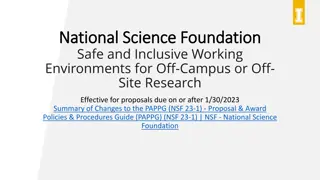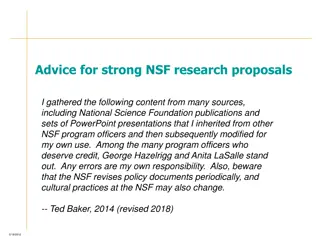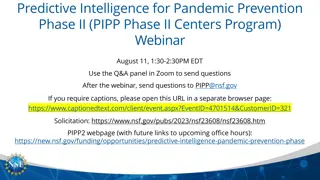NSF Engineering Research Centers Webinar Aug 31, 2015
The NSF Engineering Research Centers (ERC) program offers guidance for developing preliminary proposals, focusing on new features, fundamental questions, review criteria, and budget details for potential center proposals. Key topics include leadership, workforce development, infrastructure, innovation, and strategic planning. The webinar aims to assist researchers in aligning their ideas with national needs and creating impactful ERC proposals with integrated research, workforce development, and innovation strategies.
Download Presentation

Please find below an Image/Link to download the presentation.
The content on the website is provided AS IS for your information and personal use only. It may not be sold, licensed, or shared on other websites without obtaining consent from the author.If you encounter any issues during the download, it is possible that the publisher has removed the file from their server.
You are allowed to download the files provided on this website for personal or commercial use, subject to the condition that they are used lawfully. All files are the property of their respective owners.
The content on the website is provided AS IS for your information and personal use only. It may not be sold, licensed, or shared on other websites without obtaining consent from the author.
E N D
Presentation Transcript
ERC Solicitation 15-589 Webinar Guidance for Preliminary Proposal Development Aug 31, 2015 10:00 AM EDT Engineering Research Centers Program Division of Engineering Education and Centers Engineering Directorate, NSF 1
Format and Team for the Webinar Gen-3 ERC New Features: NSF 15-589 o ENG/EEC Leadership Proposals o Program/Proposal Guidance - Keith Roper, ERC Leader/EEC o Vision, Strategic Planning, Research - Keith Roper, ERC Leader/EEC Workforce Development o University Elliot Douglas, Engineering Education Program Director/EEC o Pre-college Mary Poats, RET Program Director (PD)/EEC Infrastructure o Broadening Participation James Moore, Broadening Participation PD/EEC o Infrastructure - Carmi a Londo o, Engineering Research Centers PD/EEC Innovation Ecosystem o Deborah Jackson, Engineering Research Centers PD/EEC 2
NSF 15-589 New Features Three Fundamental Questions What is the compelling new idea and how does it relate to national needs? Why is a center necessary to tackle the idea? How will the ERC's infrastructure integrate and implement research, workforce development and innovation ecosystem development efforts to achieve its vision? Specific Review Criteria Integrated Strategic Plans for Research, Workforce Development, Innovation Leadership: expertise in research, workforce development, and innovation o Diversity Director: experienced in proven activities to create culture of inclusion Research: impact, benchmarking, partnerships, system-at-scale Workforce Development: literature-based, inclusive, assessment Innovation: scale-able, sustainable, community Infrastructure: plan for community of inclusion 3
NSF 15-589 New Features Budget Increase Ramps $250,000 per year from $3.5M (Yr 1) to $4.25M (Yr 4) Additional features 9 pages (Preliminary Proposal) + 1 page three-plane chart Open Topic or Nanosystem ERC Proposal features o Proposed vision: transformative, unique, convergent o Strategic plans: critical path, resources, adaptive Advisory boards o Workforce Development Advisory Board o Incorporate guidance of advisory boards regularly into strategic management of the Center 4
New Features Q&A 5
Engineering Research Centers Program 6
ERC Program Goals Create a culture in academia that: Links interdisciplinary scientific discovery to technological innovation Produces diverse engineering graduates who will be highly effective in industrial practice and creative innovators in a global economy Partners with industry and other practitioners to develop a healthy innovation ecosystem 7
ERC Key Features Guiding strategic engineered systems vision that: o joins fundamental research, enabling technology, and transformational engineered systems research to realize proofs of principle and innovation o develops an innovative, globally competitive, and diverse engineering workforce Strategic plans o motivate and guide the research, education, and innovation programs to achieve the vision o drive selection, integration of research through testbed proofs of principle Interdisciplinary, systems motivated research program o fundamental and applied research o enabling and systems technology, demonstrated in academic-scaled proof- of-concept test beds; 8
Whats an Engineered System? A combination of components and elements that work together to perform a useful function New technology platform for: o new product line or new manufacturing process o transforming public sector, healthcare services, or infrastructure services Research is designed to: o address fundamental barriers o advance proofs of principle in test beds o incorporate factors effecting system-wide performance (e.g., utility, efficiency, resilience, etc.) 9
An NSF Engineering Research Center: A Complex, Interdependent System 10
Principal Investigator (PI): Eligibility Requirements Tenured faculty member in an engineering department/school of engineering at the lead university o Ph.D. in engineering; or o Ph.D. in associated field of science with: Substantial career experience in engineering Primary appointment in an engineering department or school of engineering PI and co-PIs: expertise in research, workforce development, and innovation 12
Lead University: Eligibility Requirements Submission as lead university only by a U.S. University with: B.S., M.S., and Ph.D. engineering degree programs Breadth and depth to support proposed vision 13
Institution Serving Large Numbers of Minority Groups Underrepresented in Engineering Must be lead or partner institution May classify under Dept of Education guidelines: http://www2.ed.gov/about/offices/list/ocr/edlite- minorityinst.html ; or Document significant enrollment of minority students (i.e., African Americans, Pacific Islanders, Native Americans, Hispanic Americans, and persons with disabilities who are U.S. citizens of Permanent Residents) who are majoring in engineering studies to qualify; and Document graduation track record of underrepresented minority groups 14
Invited Full Proposal: Organizational Requirements Lead and up to four domestic partner universities or colleges (one serving large numbers of underrepresented groups) that commit to cost share and participate in all ERC frameworks Fee paying industry partners, including practitioner organization partners as appropriate Long-term pre-college institutional partners State/local government and/or university/private innovation partners to stimulate innovation and entrepreneurship Commitment to include participating foreign partners/collaborators (in proposal or future) 15
Invited Full Proposal: Organizational Options Affiliated universities/colleges/institutions that: o Academic institutions that provide 2 faculty for specific research and/or education tasks o Federal laboratories providing staff for specific tasks (cannot be supported by NSF funds) Community colleges and/or technical colleges that participate in the education programs 16
Pre-proposal feedback from NSF: July Oct 22, 2015 Teleconference with ERC Program Director o Send email to kroper@nsf.gov with 10-sentence summary of ERC engineered system, including the research focus, engineering workforce development program, and innovation ecosystem and 3- plane diagram o You will be contacted by ERC Program Director (PD) to arrange a teleconference with your team for a maximum of 45 minutes. o Send slides (maximum of 10) for discussion in advance. Slides should address the proposed vision, strategic plan, research thrusts, workforce development (education), innovation ecosystem, infrastructure, and 3-plane chart. 17
Letter of Intent (LOI): Due Sept 25, 2015 Required in Order to Submit a Pre-Proposal Used by NSF to determine proposal load and form preliminary sets of reviewers PI may only submit a preliminary proposal, if an LOI is submitted There will be no official response from NSF regarding the LOI 18
Letter of Intent (LOI): Submission Requirements Identify one to four participating partner universities Multiple LOIs may be submitted by lead university PI (Center Director) may submit only one LOI No change in partners, PI, or co-PIs between LOI submission and preproposal 19
PI and Co-PI: Limitations Submitting PI (Center Director) may submit only one LOI and one preliminary proposal o PI is binding after submission of the preliminary proposal PI may not participate in any other LOI or preliminary proposal, while a PI Co-PI may participate in more than one LOI or preliminary proposal No change in PI or Co-PIs between LOI submission and preliminary proposal Co-PIs may change after acceptance to submit full proposal 20
Preliminary Proposal: Due Oct 23, 2015 Project Summary (1 page) Nine-page preliminary proposal o Proposing team o Brief summaries of the vision, research, workforce development (education), innovation ecosystem 1-page 3-plane strategic planning chart References cited Biographical sketches No budget Supplementary document: Letter of commitment from Dean of Engineering, lead university No other supporting documents, no lists of firms, etc. Send PI, Co-PI, and Participant Table to ercintent@nsf.gov 21
Preliminary Proposal: Organizational Requirements Lead and up to four partner institutions committed to participate in the research and education programs of the ERC Minimum of three faculty and three student participants must be at each partner institution No other partners and no member firms at this stage Lead is binding throughout the process 22
Preliminary Proposal: Submission Limits No limit on the number of preliminary proposals a university may submit The PI may submit only one preliminary proposal If the PI leaves the submitting university, the proposal remains with the submitting university 23
Preliminary and Invited Full Proposal: Submission and Award Limits University with more than one funded ERC, in ERC classes of 2006-2015 by October 1, 2016, may not submit a preliminary proposal o But, it may be a partner in other preliminary ERC proposals No limit on the role of the lead university as a partner in other proposals Lead university may receive only one award as lead in NSF 15-589 24
Preliminary Proposal: Review Process LOIs to be used to form panels around technology areas Panels to be finalized upon receipt of the proposals Proposals to be sent out for review in Oct-Dec 2015 Panels to be held in December 2015 Invitations for Full proposals to be sent in January - February 2016 Full proposals are due June 16, 2016 Up to four awards will be made, depending on budget Awards to be notified: Sept. 2017). 25
Program Level Overview/Guidance for Proposals Q&A 26
Vision, Strategic Plan, Research 27
ERC Engineered Systems Vision: Topic Area Open Topic ERC o Engineered system(s) chosen by the PI Nanosystems ERC o Engineered system(s) chosen by the PI o Vision requires a substantial body of new fundamental nanoscale research o Scaling from fundamentals to devices, components, and systems to assure sustained nano-enabled functionality No preference at NSF for either topic area 28
ERC Engineered Systems Vision: Qualities and Best Practices Transformative: discoveries and basic research drive compelling advances toward an emerging, potentially revolutionary technology system o Potential to significantly change current practices, establish new industries, transform public sector services, healthcare, or the infrastructure, etc. o Could increase national competitiveness or contribute to the solution of a major societal problem with national or, perhaps, international impact Convergent: Envisioned results are achievable in 10 years by strategic alignment of nascent discoveries, existing capabilities, and resources 29
ERC Engineered Systems Vision: What doesn t qualify? Not unique: o Engineered systems topics that significantly overlap an ongoing or graduated ERC do not qualify o Discussion of added value relative to achievements and/or plans of other related large centers is lacking o Added value relative to achievements and/or plans of other large centers is not significant Proposals focused on transformations of engineering education as an engineered system do not qualify o However, proposals that address educational technology as an engineered system would qualify 30
ERC Vision, Strategy, and Research: What doesn t fit the ERC model? Insufficient resources (e.g., knowledge/technology base, personnel, infrastructure, etc.) to integrate research with enabling technology, reach milestones, and realize proof of principles in systems test beds within 10 years. Unbalanced focus on exploration of a phenomena, discovery, technology improvement, or innovation without clear systems integration and/or end-to-end strategic planning. Proposed work is incremental without compelling transformational impact - too applied. State of the art advances in basic research or commercial capabilities are unanticipated, overlooked, or not integrated into planned resources/activities to achieve vision. 31
Preliminary Proposal: 9-Page Project Description Requirements (p.23) Infrastructure: PI/co-PIexpertise in discovery, workforce development, innovation Ten-year vision to link discovery to transformational engineered system and its impact Strategic Research Plan o Identifies barriers, gaps, and requirements based on review of state of the art o Leverages recent internal & external breakthroughs to achieve vision o Aligns resources to support critical path actions, and adapts, to disrupt state of the art Research: addresses barriers to achieve ERC vision at fundamental, technological, and proof-of-concept, test-bed levels. Workforce Development: literature-based, inclusive, K-grad approach to achieve goals (e.g., skill sets) via curricula and activities that evolve based on assessment Innovation Ecosystem: Strategic selection of sectors/firms, specification of roles of industry/ practitioner members, and cultivation of innovation in the ERC. o Do not list potential or committed industrial or other supporters Dean s Letter plus required NSF proposal documents. No other supporting letters. 32
Preliminary Proposal: Preparing the Proposal Study the guidance and full proposal requirements (pp. 5-6, 15, 23-24) Summarize your plan in the light of the requirements Include your 3-plane strategic planning chart o download: http://www.erc-assoc.org/funding_opportunities 33
ERC Strategic Planning: Organizing the Research Program Context for ERC vision: barriers, knowledge gaps, and requirements are o identified by comprehensive state of the art analysis o informed by environmental, societal, and other factors Critical path: resources allocated to leverage internal/external discoveries to achieve quantifiable milestones to realize system goals, ERC vision o 10-yr milestone chart plots deliverables and interdependencies Resources: defines required support for interdisciplinary projects and thrusts is necessary to bridge barriers and gaps to achieve systems requirements. Guides resource allocation to reach technology and systems-level milestones (via metrics, figures of merit) and deliverables. Adaptive: provides flexibility to evolve as discoveries and advances are made and new barriers/challenges arise Requirements and barriers motivate selection, refining, and pruning of projects at fundamental, enabling technology, and systems levels 34
ERC Strategic Framework: Proposal #, PIName, ERC Name, Lead University Name Barriers Test Bed(s) Systems Research QoLT 3-plane chart Requirements Test Bed(s) Stakeholders Systems Research Test Bed(s) Products & Outcomes Systems Technology Integration Technology Elements Technology Elements Barriers Enabling Technology Research Test Beds Test Beds System Requirements Test Beds Enabling Technology Research Enabling Technologies Technology Base Fundamental Insights Barriers Fundamental Research Fundamental Research Fundamental Research Fundamental Research Fundamental Research Fundamental Research 35 Fundamental Knowledge Knowledge Base
ERC Research Program: Thrusts and Test Beds Thrusts: integrate fundamental and enabling technology research into clusters of interdependent, aligned projects a research thrust. Test Beds: guide research activity to bring technology to proofs of principle that realize the ERC vision o System test beds prove ERC-wide technology advances o Intra-thrust testbeds prove thrust-wide enabling technology advances Both motivated by ERC s strategic research plan o Projects selected to address ERC s research/technology barriers, gaps, and requirements of engineered systems Interdisciplinary teams form across partner institutions Interdependence among projects and across thrusts 36
ERC Research Program: Thrust Level Pre-Proposal Content Justify basic and enabling technology research in light of o state of the art: commercially available and basic research o barriers, gaps, or requirements the thrust will address Provide examples of o research projects and methods to be used o recent and targeted breakthroughs achievable in the context of the ERC s milestones Clarify role of the thrust in o contributing to enabling and systems technology test beds o interdependency and alignment with other thrusts 37
ERC Test Bed: Qualities and Best Practices Enable proofs of principle at o technology level (within or across thrusts) o engineered systems level (ERC-wide) Test beds often need technical staff to build and operate equipment/infrastructure Test beds are a critical part of the education and innovation ecosystem of an ERC Systems test beds need leaders to set goals, set deliverables from research, assure integration, and realize proofs of principle 38
Vision, Strategic Plan, Research Q&A 39
Engineering Workforce Development University and Pre-College Education 40
ERC Workforce Development: Objectives and Features University Education: Infuses ERC knowledge into curriculum to prepare undergraduate and graduate students who are: o knowledgeable in industrial practice, e.g., adept team workers, experienced in advancing technology, ethical, and entrepreneurial o creative, innovative, adept communicators, and life-long learners o able to integrate knowledge across disciplines to advance technology o experienced in working in non-U.S. research cultures Long-term pre-college Partnerships: Up to five institutions whose STEM faculty: o participate in structured engineering learning and activities o integrate ERC-based course modules into their curriculum o attract underrepresented groups to engineering research experiences 41
ERC University Education: Infrastructure Requirements Workforce Development Program Director o member of ERC leadership team o staff or faculty experienced in research-based pedagogical and experiential approaches to student development o leads planning, implementation, and refinement of workforce development in university and pre-college programs Workforce Development Advisory Board (WDAB) o external experts in workforce development, broadening participation, and education o meet annually with Center and site visit team to provide guidance to ERC workforce development plan, activities, and advances 42
ERC University Education: Program Requirements Strategic Education Plan o aligned with plans for research, innovation, and inclusion o identifies research-based pedagogical and experiential approaches to achieve objectives of ERC workforce development o organizes integrated efforts to produce ERC graduates that meet objectives of the ERC university and pre-college programs o coordinates interactions between ERC, WDAB, community/technical colleges to attract and graduate minority students Global Exchange o Students conduct ERC-relevant research in industry and foreign labs o Cyberinfrastructure and student experiences enable rapid translation of ERC results across the ERC, innovation ecosystem, and nation 43
ERC University Education: Program Requirements Skill Sets o ERC develops technical and transferable professional skills of ERC students o identifies research-based curricula, activities, mentors, etc. to impart these skills o 1 undergraduate student per 2 graduate students to be trained in labs Curricular Impact o modules, content, certificates, new degree programs derived from ERC o all partner institutions infuse engineering curricula with ERC experiences, o Summer REU program for non-ERC students. Minimum $42K/yr support and 6 students enrolled 44
ERC Pre-college Education: Program Requirements Engagement: innovative best practices and effective efforts to o teach engineering concepts derived from ERC research o engage ERC faculty and students to stimulate K-12 interest in engineering careers and increase diversity o support P-12 faculty development to sustain pre-college teaching of engineering concepts Partnership: up to 5 pre-college institutions near ERC that o support engineering research education and experiences for their faculty and students o introduce high school students to research in university labs o involve K-CC STEM faculty in RET program to experience research o sustain follow-up to ensure RET experience is translated to K-CC curricula 45
ERC Assessment: Program Requirements Smart, measurable, attainable, realistic, and timely goals identified at Graduate and Pre-college levels External formative and summative evaluation of progress and achievement of goals within Center lifetime. External evaluations and Workforce Development Advisory Board feedback are used regularly to improve workforce development program Full proposal requires institutional review board approval 46
Engineering Workforce Development Q&A 47
ERC Culture of Inclusion: Program Requirements Vision o Compelling path to broaden participation among groups underrepresented in engineering, exceeding national averages o Inclusivity and diversity among faculty, students, and staff at all levels o Lead and all partner institutions cultivate inclusivity and diversity Strategic Inclusion Plan o aligned with plans for research, education, and innovation o identifies gaps, barriers, and requirements for inclusive participation o establishes goals, appropriate milestones, actionable plans o partners with existing programs and offices at lead and partner institutions to achieve positive outcomes 49
ERC Culture of Inclusion: Infrastructure Requirements Diversity Director o member of ERC leadership team o staff or faculty experienced in the development, implementation, and assessment of proven activities to create culture of inclusion o leads recruitment-to-graduation of underrepresented groups in engineering fields among ERC participants Workforce Development Advisory Board (WDAB) o includes external expert(s) in broadening participation o meets annually with Center and site visit team to provide guidance to achieve objectives of ERC Culture of Inclusion 50
